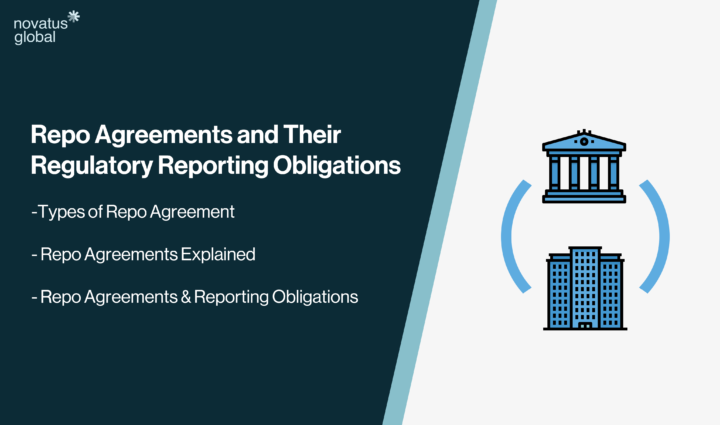
Repo Agreements and Their Regulatory Reporting Obligations
A Repo Agreement is another name for a repurchase agreement that involves the sale and repurchase of a security, typically government bonds. The sale is conducted with the agreement that the seller will repurchase the same security at a specified date and price. The specified price is usually higher than the initial sale. Repos are considered to be a form of secured financing, with the security acting as collateral. In this way, the lender is covered against any credit risk which helps them to cover their losses if the seller cannot repay.
Key Components of Repo Agreements
Repo agreements are most common with banks, hedge funds and other large financial entities and may be used to sell securities such as government bonds to secure short-term capital. These institutions have the reputation and the collateral to support such a transaction, and as such they are commonly used to address short-term liquidity needs such as overnight funding to finance larger market positions.
This first part of a repo is called the “near leg”. In this case, the bank or hedge fund sells the security or bond to a buyer with the promise to buy it back at a future date at a higher price. When they repurchase the security at the agreed time and price, this is known as the “far leg”.
Repos are short-term in nature with most agreements settled within 12 – 48 hours, depending on the agreed-upon timeframe between parties. The interest rate of a repo transaction is referred to as the repo rate and is calculated as the difference between the sale and repurchase prices.
Types of Repo Agreements
There are three main types of repo transactions:
-
-
- Third-party repos (Tri-party repos): involve a third-party clearing agent, usually a bank, who holds the securities and the cash exchange during the repo process. Upon maturity, the seller will pay and the third-party clearing agent returns the security to the buyer. Tri-party repos are more common in the US than in the EU, accounting for around 60% of repo settlements, compared to roughly 10% in the EU market, where counterparties typically negotiate without an intermediary.
- Term repos: refers to a repurchase agreement with an agreed maturity date. This can be overnight or to any date agreed upon by both parties.
- Open repos – refers to a repurchase agreement with no maturity date. In an open repo, either party can terminate at any time.
-
Repo Market Participants
Repos are an important financial instrument that can be used to raise short-term capital to meet overnight liquidity needs. Institutional investors often use repos to invest surplus funds in a low-risk transaction.
Central banks such as the US Federal Reserve and the Bank of England use repo markets as a tool to manage liquidity, control interest rates, and implement monetary policy more efficiently. Purchasing securities through repo agreements allows central banks to inject cash into the financial system, thereby increasing liquidity. To tighten liquidity and increase reserves, central banks engage in reverse repos, selling securities to reduce overall liquidity.
Risks in Repo Agreements
Repos are considered secured loans, but there are still risks involved in a repo transaction, mainly that the seller will default. If this happens, the security buyer will then typically liquidate the collateral security held to recoup their potential losses.
In cases where the collateral used to secure the repo has depreciated in value at the time of the sale, the security buyer could be left with a loss. To combat this risk, there are several strategies that can be used to protect the buyer:
-
-
- Overcollateralisation: the security involved in the repo agreement is worth more than the loan’s value so that the security buyer won’t make a loss if the seller defaults.
- Haircuts: a percentage reduction to the value of the collateral used in a repo transaction, providing security to the buyer should the value of the collateral fall before the repo matures.
- Margin Calls: are activated when the value of the collateral used to secure the repo falls below a specified threshold. At this point, the seller must provide further collateral to secure the repo. If the seller fails to meet the margin call, the buyer can liquidate to cover any losses.
-
Repo Transactions and Financial Regulation
Repo Agreement Regulation in Europe
The Securities Financing Transactions Regulation (SFTR), was introduced by the European Union in January 2016 and has been overseen by the European Securities and Markets Authority (ESMA) since its creation.
Since a repo is a Securities Financing Transaction (SFT), it must be reported to a Trade Repository (TR) under SFTR on a T+1 basis. Repo transactions with the European System of Central Banks (ESCB) are not reportable under SFTR and are, therefore, reportable under MiFID ii/MiFIR, depending on the individual circumstances of each transaction. Repo transactions with other central banks such as the Bank of England and the European Central Bank are also exempt from SFTR reporting requirements.
MiFIR outlines that any transactions with SFTR reporting obligations are exempt from MiFIR reporting requirements. Best execution rules also apply to repos, with best execution data needing to be collected and retained for at least five years.
Post-Brexit, the UK has adopted the EU SFTR into its domestic legal framework, known as onshoring. This process ensures that SFTR reporting requirements continue to apply to UK-based entities and transaction reporting has remained mostly consistent. However, the UK has diverged from EU SFTR slightly in terms of reporting exemptions for Non-Financial Counterparties (NFCs) and the treatment of certain counterparties such as the Bank of England.
The ESMA’s 2024 market report on SFTs disclosed that in September 2023, repos comprised 68% of total outstanding SFT exposure in the SFTR database.
Repo Agreement Regulation USA
In May 2024, the Office of Financial Research (OFR) published the “Final Rule” requiring the reporting and collection of data for the Non-Centrally Cleared Bilateral Repo market (NCCBR). This introduces a daily reporting requirement for certain brokers, dealers and other financial companies with large exposures to the NCCBR to send data to the OFR, allowing the Financial Stability Oversight Council (FSOC) and other NCAs to monitor for risks and manage stability.
Ensuring Your Regulatory Reporting Requirements
Novatus Global offer a comprehensive range of bespoke transaction reporting services to meet every client’s needs.
Novatus En:ACT is the market-leading pure SaaS transaction reporting platform designed to solve the most significant transaction reporting requirements for firms with G20 reporting requirements.
If you’re looking to streamline your transaction reporting processes, ensure compliance with regulatory requirements or address complex reporting challenges our team of experts has the knowledge and experience required to support you every step of the way. Get in touch today.












